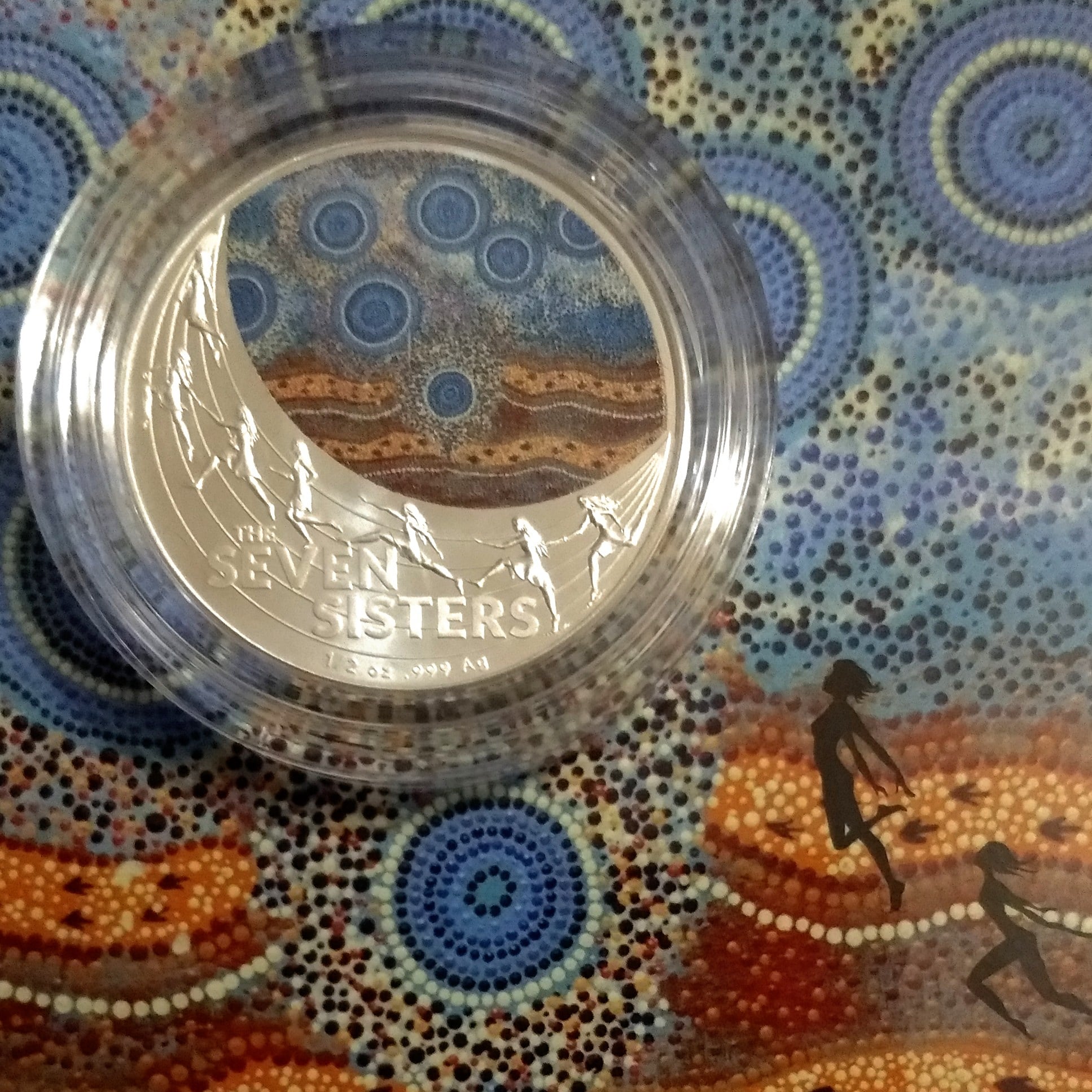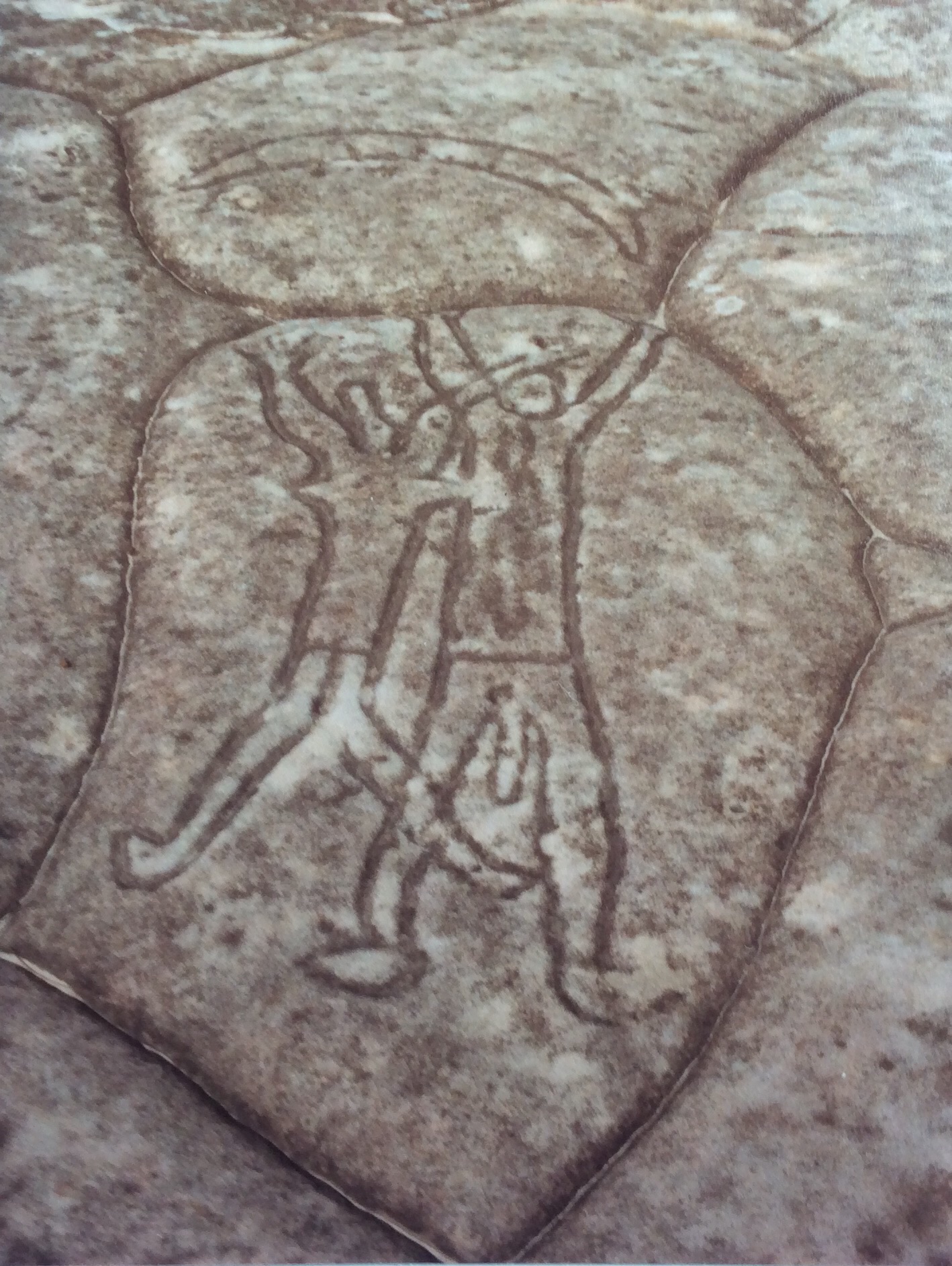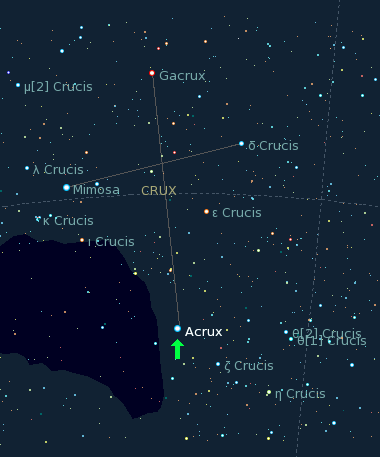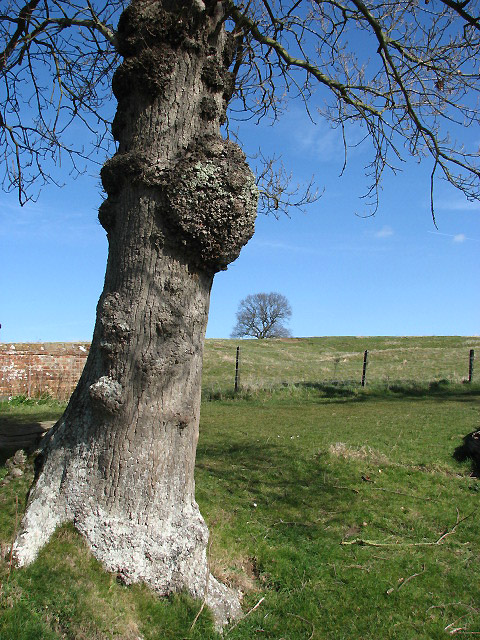|
Daramulan
In Aboriginal cultures of south-east Australia, Daramulum (variations: Darhumulan, Daramulan, Dhurramoolun or Dharramaalan) (“one legged”, from dharra 'leg, thigh' + maal 'one' + -an suffix) is a sky hero associated with Baiame, and an emu-wife. He is a shapeshifter. Engravings of Daramulum are sometimes accompanied by indentations that may represent star groups. Daramulum is depicted on rock art off Elvina Track in Ku-ring-gai Chase National Park, near to a carving of his emu-wife. He is depicted in semi-profile, with one arm, an emu-back (i.e. pointed buttocks), and a large foot. His voice can be heard through the medium of the bullroarer which is whirled through the air during initiation ceremonies. He now lives in the trees of the bush, particularly in the burls or growths which are found on the trunks of trees, and only leaves them for initiation ceremonies. The bullroarer must be cut from a tree which contains his spirit for it to work. For the Guringai, Daramulum ... [...More Info...] [...Related Items...] OR: [Wikipedia] [Google] [Baidu] |
Australian Aboriginal Astronomy
Australian Aboriginal astronomy is a name given to Aboriginal Australian culture relating to astronomical subjects – such as the Sun and Moon, the stars, planets, and the Milky Way, and their motions on the sky. Traditional Aboriginal culture and mythology and religion include many components of astronomy, and these traditions have been passed down orally, through ceremonies, and in their artwork of many kinds. The astronomical systems passed down thus show a depth of understanding of the movement of celestial objects which allowed them to use them as a practical means for creating calendars and for navigating across the continent and waters of Australia. There is a diversity of astronomical traditions in Australia, each with its own particular expression of cosmology. However, there appear to be common themes and systems between the groups. Due to the long history of Australian Aboriginal astronomy, the Aboriginal peoples have been described as "world's first astrono ... [...More Info...] [...Related Items...] OR: [Wikipedia] [Google] [Baidu] |
Sydney Rock Engravings
Sydney rock engravings, or Sydney rock art, are a form of Australian Aboriginal rock art in the sandstone around Sydney, New South Wales, Australia, that consist of carefully drawn images of people, animals, or symbols. Many thousands of such engravings are known to exist in the Sydney region, although the locations of most are not publicised to prevent damage by vandalism, and to retain their sanctity, as they are still regarded as sacred sites by Indigenous Australians. There are two art environments in Sydney Basin, rock shelters and engraving sites. There are 1,500 pieces of Aboriginal art in Sydney, more than half of which contain rock art, and around 1,500 caves or shelters which contain cultural deposit. They are comparable with the petroglyphs of Native Americans and the rock art found elsewhere in Australia, but have their own distinctive style which is quite unlike rock art found anywhere else in Australia. Dating to around 5,000 years, with some possibly as old as 7 ... [...More Info...] [...Related Items...] OR: [Wikipedia] [Google] [Baidu] |
Bullroarer (music)
The bullroarer, ''rhombus'', or ''turndun'', is an ancient ritual musical instrument and a device historically used for communicating over great distances. It consists of a piece of wood attached to a string, which when swung in a large circle produces a roaring vibrato sound. It dates to the Paleolithic period, being found in Ukraine dating from 18,000 BC. Anthropologist Michael Boyd, a bullroarer expert, documents a number found in Europe, Asia, Africa, the Americas, and Australia. In ancient Greece it was a sacred instrument used in the Dionysian Mysteries and is still used in rituals worldwide. It was a prominent musical technology among the Australian Aboriginal people, used in ceremonies and to communicate with different people groups across the continent. Many different cultures believe that the sounds they make have the power to ward off evil influences. Design, use, and sound A bullroarer consists of a weighted airfoil (a rectangular thin slat of wood about lo ... [...More Info...] [...Related Items...] OR: [Wikipedia] [Google] [Baidu] |
Engraving Of Daramulum
Engraving is the practice of incising a design onto a hard, usually flat surface by cutting grooves into it with a burin. The result may be a decorated object in itself, as when silver, gold, steel, or glass are engraved, or may provide an intaglio printing plate, of copper or another metal, for printing images on paper as prints or illustrations; these images are also called "engravings". Engraving is one of the oldest and most important techniques in printmaking. Wood engraving is a form of relief printing and is not covered in this article, same with rock engravings like petroglyphs. Engraving was a historically important method of producing images on paper in artistic printmaking, in mapmaking, and also for commercial reproductions and illustrations for books and magazines. It has long been replaced by various photographic processes in its commercial applications and, partly because of the difficulty of learning the technique, is much less common in printmaking, where ... [...More Info...] [...Related Items...] OR: [Wikipedia] [Google] [Baidu] |
Guringai
Kuringgai (also spelled Ku-ring-gai, Kuring-gai, Guringai, Kuriggai) (,) is an ethnonym referring to (a) an hypothesis regarding an aggregation of Indigenous Australian peoples occupying the territory between the southern borders of the Gamilaraay and the area around Sydney (b) perhaps an historical people with its own distinctive language, located in part of that territory, or (c) people of Aboriginal origin who identify themselves as descending from the original peoples denoted by (a) or (b) and who call themselves Guringai. Origins of the ethnonym In 1892, ethnologist John Fraser edited and republished the work of Lancelot Edward Threlkeld on the language of the Awabakal people, ''An Australian Grammar'', with lengthy additions. In his "Map of New South Wales as occupied by the native tribes" and text accompanying it, he deploys the term ''Kuringgai'' to refer to the people inhabiting a large stretch of the central coastline of New South Wales. He regarded the language descr ... [...More Info...] [...Related Items...] OR: [Wikipedia] [Google] [Baidu] |
Australian Aboriginal Mythology
Australian Aboriginal religion and mythology is the sacred spirituality represented in the stories performed by Aboriginal Australians within each of the Aboriginal Australian languages, language groups across Australia in their Aboriginal ceremonies, ceremonies. Aboriginal spirituality includes The Dreaming, the Dreamtime (''the Dreaming''), songlines, and Aboriginal oral literature. Aboriginal spirituality often conveys descriptions of each group's local cultural landscape, adding meaning to the whole country's topography from oral history told by ancestors from some of the earliest recorded history. Most of these spiritualities belong to specific groups, but some span the whole continent in one form or another. Antiquity An Australian Linguistics, linguist, R. M. W. Dixon, recording Aboriginal myths in their original languages, encountered coincidences between some of the landscape details being told about within various myths, and Hard science, scientific discoveries bein ... [...More Info...] [...Related Items...] OR: [Wikipedia] [Google] [Baidu] |
Yuin
The Yuin nation, also spelt Djuwin, is a group of Aboriginal Australians, Australian Aboriginal peoples from the South Coast (New South Wales), South Coast of New South Wales. All Yuin people share ancestors who spoke, as their first language, one or more of the Yuin–Kuric languages, Yuin language dialects. Sub-groupings of the Yuin people are made on the basis of language and other cultural features; groups include the Brinja or Brinja-Yuin, Budawang, Murramarang, Yuin-Monaro, Djiringanj, Walbunja, and more. They had a close association with the Thaua people. Name and identity The ethnonym ''Yuin'' ("man") was selected by early Australian ethnographer, Alfred William Howitt, Alfred Howitt, to denote two distinct tribes of News South Wales, namely the Djiringanj and the Thaua. In Howitt's work, the Yuin were divided into northern (Kurial-Yuin) and southern (Gyangal-Yuin) branches. The term "Yuin" is commonly used by South Coast Aboriginal people to describe themselves, alt ... [...More Info...] [...Related Items...] OR: [Wikipedia] [Google] [Baidu] |
Crux
Crux () is a constellation of the southern sky that is centred on four bright stars in a cross-shaped asterism commonly known as the Southern Cross. It lies on the southern end of the Milky Way's visible band. The name ''Crux'' is Latin for cross. Even though it is the smallest of all 88 modern constellations, Crux is among the most easily distinguished as its four main stars each have an apparent visual magnitude brighter than +2.8. It has attained a high level of cultural significance in many Southern Hemisphere states and nations. Blue-white α Crucis (Acrux) is the most southerly member of the constellation and, at magnitude 0.8, the brightest. The three other stars of the cross appear clockwise and in order of lessening magnitude: β Crucis (Mimosa), γ Crucis (Gacrux), and δ Crucis (Imai). ε Crucis (Ginan) also lies within the cross asterism. Many of these brighter stars are members of the Scorpius–Centaurus association, a large but loose group of hot blue-whit ... [...More Info...] [...Related Items...] OR: [Wikipedia] [Google] [Baidu] |
Alpha Crucis
Acrux is the brightest star in the southern constellation of Crux. It has the Bayer designation α Crucis, which is Latinised to Alpha Crucis and abbreviated Alpha Cru or α Cru. With a combined visual magnitude of +0.76, it is the 13th-brightest star in the night sky. It is the most southerly star of the asterism known as the Southern Cross and is the southernmost first-magnitude star, 2.3 degrees more southerly than Alpha Centauri. This system is located at a distance of 321 light-years from the Sun. To the naked eye Acrux appears as a single star, but it is actually a multiple star system containing six components. Through optical telescopes, Acrux appears as a triple star, whose two brightest components are visually separated by about 4 arcseconds and are known as Acrux A and Acrux B, α1 Crucis and α2 Crucis, or α Crucis A and α Crucis B. Both components are B-type stars, and are many times more massive and luminous than the Sun. α1 Crucis is itself a spe ... [...More Info...] [...Related Items...] OR: [Wikipedia] [Google] [Baidu] |
Initiation
Initiation is a rite of passage marking entrance or acceptance into a group or society. It could also be a formal admission to adulthood in a community or one of its formal components. In an extended sense, it can also signify a transformation in which the initiate is 'reborn' into a new role. Examples of initiation ceremonies might include Christian baptism or confirmation, Jewish bar or bat mitzvah, acceptance into a fraternal organization, secret society or religious order, or graduation from school or recruit training. A person taking the initiation ceremony in traditional rites, such as those depicted in these pictures, is called an ''initiate''. See also rite of passage. Characteristics William Ian Miller notes the role of ritual humiliation in comic ordering and testing. Mircea Eliade discussed initiation as a principal religious act by classical or traditional societies. He defined initiation as "a basic change in existential condition", which liberates man from p ... [...More Info...] [...Related Items...] OR: [Wikipedia] [Google] [Baidu] |
Burl
A burl (American English) or burr (British English) is a tree growth in which the grain has grown in a deformed manner. It is commonly found in the form of a rounded outgrowth on a tree trunk or branch that is filled with small knots from dormant buds. Burl formation is typically a result of some form of stress such as an injury or a viral or fungal infection. Burls yield a very peculiar and highly figured wood sought after in woodworking, and some items may reach high prices on the wood market. Poaching of burl specimens and damaging the trees in the process poses a problem in some areas. Description A burl results from a tree undergoing some form of stress. It may be caused by an injury, virus or fungus. Most burls grow beneath the ground, attached to the roots as a type of malignancy that is generally not discovered until the tree dies or falls over. Such burls sometimes appear as groups of bulbous protrusions connected by a system of rope-like roots. Almost all burl ... [...More Info...] [...Related Items...] OR: [Wikipedia] [Google] [Baidu] |
Indigenous Australians
Indigenous Australians or Australian First Nations are people with familial heritage from, and membership in, the ethnic groups that lived in Australia before British colonisation. They consist of two distinct groups: the Aboriginal peoples of the Australian mainland and Tasmania, and the Torres Strait Islander peoples from the seas between Queensland and Papua New Guinea. The term Aboriginal and Torres Strait Islander peoples or the person's specific cultural group, is often preferred, though the terms First Nations of Australia, First Peoples of Australia and First Australians are also increasingly common; 812,728 people self-identified as being of Aboriginal and/or Torres Strait Islander origin in the 2021 Australian Census, representing 3.2% of the total population of Australia. Of these indigenous Australians, 91.4% identified as Aboriginal; 4.2% identified as Torres Strait Islander; while 4.4% identified with both groups. [...More Info...] [...Related Items...] OR: [Wikipedia] [Google] [Baidu] |









.jpg)
